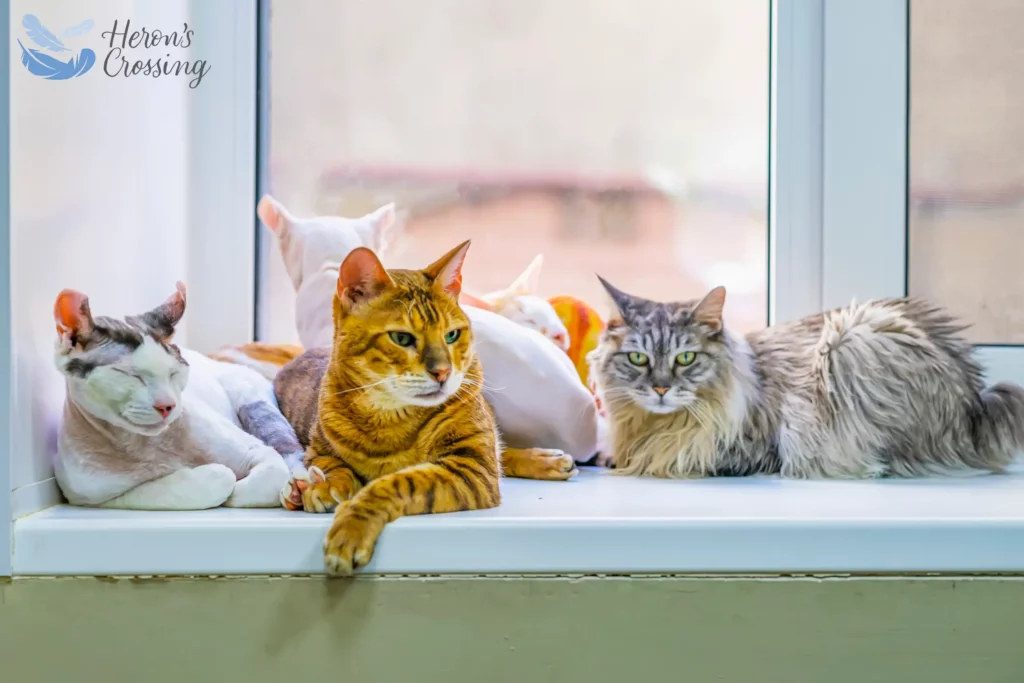People who have cats usually love cats, so they often have more than one. It can be a challenge to keep them all happy and healthy.
Rules
Start by establishing boundaries such as meal times and play areas, basic commands, and basic rules, like keeping claws clipped.
Pets pick up on our feelings. Set the tone for them with a pleasant home. It helps to have lots of sunlight, and windows to watch the world, plus a multi-cat pheromone to relax everyone, and some small fans or windows open slightly to circulate the air and keep it smelling fresh.
Family Fun
Treat each cat as a cherished individual, and make special time for each one. Encourage these little loners to play together, but don’t force it. Share treat times or ‘family time’ watching bird TV, so they will learn that being together as a family can be fun.
Exercise
Give yourself more time to manage your day by giving your cats lots of climbing opportunities, scratching posts and toys, plus nooks to hide in, and a variety of places for napping. Something as simple as an open cabinet or a cardboard box can provide hours of curious entertainment.
Litter
The general rule is one litter box per cat, plus an extra, placed in various quiet areas, so there is no waiting. If you have more than two cats, an automatic litter box might be worth considering. These quickly remove smelly droppings, and save a lot of time on unpleasant scooping by hand. Also get automatic room fresheners that destroy odors.
Watering
Use a gravity feeder for water, or put extra water bowls down in the morning, to avoid constant replenishing. These water sources can be communally shared, as long as there is no waiting. Many cats enjoy motorized fountains, which keep the water tasting fresh longer. Get the large capacity size with an automatic cut-off switch in case it goes dry.
Feeding
Each cat needs a separate food bowl, not a communal dish, or else you might have one fat cat and the others meowing for justice. Space the cats apart so they can relax while eating.
Household Tips
To make things easier and less expensive, buy food and litter in bulk online and have it shipped to avoid the strain of lifting it all into the cart, into the trunk and into the house. Keep wipes and pet stain remover on each floor of the house for accidents and hairballs.
Watch for These Signs
Your cats have their own hierarchy. If you notice that any have fallen in rank or are being rejected, check for signs of possible illness. Your colony will know something is wrong before you do.
Some stress signs to watch for include one of your fur babies being ostracized or always on guard, a bristled tail, angrily scratching furniture or carpeting, going outside the litter box, hiding, or grooming until the skin is raw. Isolate this cat to a safe place, then learn whether there is an aggressor and why. This behavior can also sometimes stem from illness or allergy.
It’s amazing to watch how they teach each other. Give them occasional challenges to learn such as a treat puzzle or a new way to climb up somewhere, so they can figure it out together. This will help them to bond.
Maximum Capacity
How many cats a family should have probably depends on the size of their living space and local restrictions. Most experts would say four to six is the maximum. After that, it can become difficult to keep up with their medical needs and records. Two or three tend to get along comfortably. Cats would probably vote for one kitty per lap.
Ideally, try to choose a cat who is generally the same age and temperament (active, sedate or curious), but of a different gender, so they will not be confrontational. Yet, if you bring in a rescue that needs a home but doesn’t fit this ‘ideal’ profile, things will work out. It will just take a little more time.
Heron’s Crossing provides end-of-life care for pets in the Metro Atlanta area. In-home appointments with compassionate vets are available. If you’d prefer a home-like setting away from your home, our Decatur office is also available by appointment.

